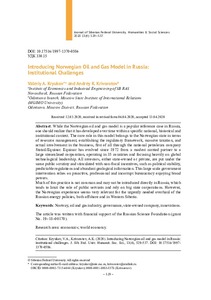Introducing Norwegian Oil and Gas Model in Russia: Institutional Challenges
Скачать файл:
URI (для ссылок/цитирований):
https://elib.sfu-kras.ru/handle/2311/135188Автор:
Kryukov, Valeriy A.
Krivorotov, Andrey K.
Крюков, В.А.
Криворотов, А.К.
Дата:
2020-04Журнал:
Журнал Сибирского федерального университета. Гуманитарные науки. Journal of Siberian Federal University. Humanities & Social Sciences;2020 13 (4)Аннотация:
While the Norwegian oil and gas model is a popular reference case in Russia,
one should realize that it has developed over time within a specific national, historical and
institutional context. The core role in this model belongs to the Norwegian state in terms
of resource management, establishing the regulatory framework, massive taxation, and
actual involvement in the business, first of all through the national petroleum company
Statoil/Equinor. Equinor has evolved since 1972 from a modest carried partner to a
large streamlined corporation, operating in 35 countries and focusing heavily on global
technological leadership. All investors, either state-owned or private, are put under the
same public scrutiny and stimulated with non-fiscal incentives, such as political stability,
predictable regulations and abundant geological information. This large scale government
intervention relies on proactive, professional and incorrupt bureaucracy enjoying broad
powers.
Much of this practice is not common and may not be introduced directly in Russia, which
tends to limit the role of public servants and rely on big state corporations. However,
the Norwegian experience seems very relevant for the urgently needed overhaul of the
Russian energy policies, both offshore and in Western Siberia Хотя норвежская нефтегазовая модель является популярным примером
успешной организации отрасли, которую многие воспринимают как один из
возможных эталонов для внедрения в России, следует понимать, что она развивалась
с течением времени в рамках конкретного национального, исторического и
институционального контекстов. Ключевая роль в этой модели принадлежит
Норвежскому государству с точки зрения управления ресурсами, создания
нормативной базы, налогообложения и фактического участия в бизнесе в первую
очередь через национальную нефтяную компанию Statoil/Equinor. С 1972 года
Equinor превратилась из скромного партнера в крупную корпорацию, работающую
в 35 странах и уделяющую большое внимание мировому технологическому
лидерству. Все инвесторы, как государственные, так и частные, подконтрольны
обществу и стимулируются нефискальными стимулами, такими как политическая
стабильность, предсказуемое регулирование и изобилие геологической
информации. Такое широкомасштабное государственное вмешательство опирается
на активную, профессиональную и неподкупную бюрократию, обладающую
широкими полномочиями.
Большая часть этой практики не распространена и не может быть внедрена
непосредственно в России, которая, как правило, ограничивает роль государственных
служащих и опирается на крупные государственные корпорации. Однако
норвежский опыт представляется весьма актуальным для срочного пересмотра
российской энергетической политики как на шельфе, так и на Востоке России

